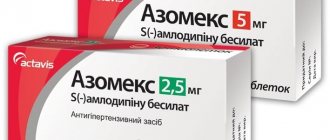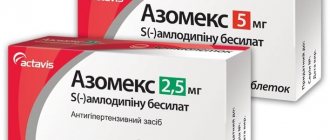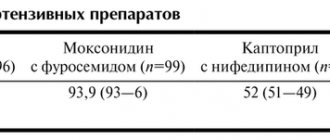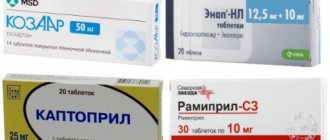Pharmacological properties of the drug Nifecard XL
Antianginal and antihypertensive agent. The drug blocks the transmembrane entry of calcium ions through selective voltage-dependent slow L-channels into smooth muscle cells of arterial vessels and myocardium. Nifedipine, like all dihydropyridine calcium antagonists, has a pronounced selectivity for vascular smooth muscle compared to the myocardium. Therefore, the main hemodynamic effect of the drug is considered to be systemic peripheral vasodilation, which leads to a decrease in peripheral vascular resistance, and as a result determines its antihypertensive effect. The antianginal effect of nifedipine is associated with a decrease in cardiac afterload and, as a result, myocardial oxygen demand due to systemic vasodilation. In addition, the drug has a direct vasodilating effect on the coronary arteries of the heart; prevents the development of vasospasm. The effect of nifedipine may be due to improved diastolic relaxation of the left ventricle (normalization of diastolic filling). Other effects include a diuretic effect that blocks the effect on platelet aggregation. There is evidence that long-term use of the drug may slightly inhibit the development of atherosclerotic platelets. Nifecard XL acts more slowly than nifedipine; due to its slow release, it is almost completely absorbed after oral administration. In small quantities it passes through the blood-brain barrier, the placental barrier, and enters breast milk. Bioavailability is 40–60% due to the first pass effect through the liver. Bioavailability increases with impaired liver function. Characterized by a high percentage of binding to blood plasma proteins (92–98%). The half-life is approximately 2 hours. It is excreted mainly by the kidneys in the form of inactive metabolites, about 15% in feces. Nifecard XL, due to the delayed release of the active component, provides a gradual, controlled increase in the concentration of nifedipine in the blood plasma. The concentration of nifedipine in the blood plasma reaches a plateau after approximately 6 hours and is maintained with minor fluctuations over 24 hours.
Special instructions for the use of Nifecard XL
In case of severe arterial hypotension (systolic pressure below 90 mm Hg), severe cerebrovascular accidents, severe heart failure, severe aortic and mitral stenosis, diabetes mellitus, liver and kidney dysfunction, nifedipine can only be used under constant clinical supervision, avoiding the use of the drug in high doses. In elderly patients, increased sensitivity to the drug is possible, even when using normal doses. Nifecard XL is prescribed with extreme caution to patients on hemodialysis, with malignant hypotension or hypovolemia, since dilatation of blood vessels can cause a significant decrease in blood pressure. Separate in vitro have shown a relationship between the use of calcium antagonists, in particular nifedipine, and reversible biochemical changes in sperm that impair the ability of the latter to fertilize. Use during pregnancy and lactation. There is no data on the safety of using Nifecard XL during pregnancy, so the drug is prescribed only when the possible effect of its use outweighs the possible risk to the fetus. Nifecard XL passes into breast milk, so the drug is not prescribed during breastfeeding. Impact on psychophysical abilities. Persons who drive a car or operate machinery should be careful when taking the drug, especially at the beginning of treatment.
Side effects of Nifecard XL
Cardiovascular system: most often, especially at the beginning of treatment, tachycardia, flushing of the face and other parts of the body, headache, dizziness and decreased blood pressure, swelling of the legs (usually when using long-acting forms of the drug) were detected. Rarely - collapse, chest pain (including typical attacks of angina). In case of such adverse reactions, it is necessary to discontinue the drug. Gastrointestinal organs and liver: dyspepsia, epigastric discomfort, nausea, diarrhea. Rarely - increased levels of liver transaminases, cholestasis (impaired liver function). Hematopoietic system: rarely - anemia, leukopenia, thrombocytopenia, very rarely - agranulocytosis. Urinary system: increased daily diuresis; in patients with renal failure - progression of renal dysfunction. Allergic reactions: allergic skin reactions (rash, itching, erythema), rarely - systemic reactions, exfoliative dermatitis. Other reactions: when used in high doses, myalgia, paresthesia of the extremities, short-term visual impairment, and increased fatigue were rarely observed; very rarely - with prolonged treatment, hyperglycemia, gum hyperplasia, gynecomastia (in older men) are possible. After discontinuation of the drug, adverse reactions in most cases completely disappeared.
Overdose of Nifecard XL, symptoms and treatment
Symptoms of intoxication: headache, facial flushing, prolonged arterial hypotension, absence of pulse in the peripheral arteries. In severe cases, tachycardia or bradycardia, dysfunction of the sinus node, slowing of AV conduction, hyperglycemia, metabolic acidosis and hypoxia, collapse with loss of consciousness and cardiogenic shock accompanied by pulmonary edema are noted. Treatment: emergency measures should be aimed primarily at removing the drug from the body and restoring stable hemodynamics. It is necessary to constantly monitor the functions of the cardiovascular and respiratory systems, the levels of glucose and electrolytes (potassium, calcium) in the blood plasma, daily diuresis and blood volume. It is possible to administer calcium supplements. If calcium administration is not effective enough, it is advisable to use sympathomimetics such as dopamine or norepinephrine to stabilize blood pressure. The doses of these drugs are selected taking into account the achieved therapeutic effect. Bradycardia can be treated with β-sympathomimetics. When the heart rate slows down and is life-threatening, the use of an artificial heart pacemaker is recommended. Additional fluid administration increases the risk of cardiac overload. Since nifedipine is characterized by a high degree of binding to plasma proteins and a relatively small volume of distribution, hemodialysis is ineffective; Plasmapheresis is recommended.



